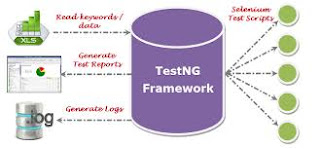Selenium TestNG with Framework
TestNG is a testing framework inspired from JUnit and NUnit. But introduce some new functionality that makes it more powerful and easier to use. It is an open source test framework where NG of TestNG means Next Generation. TestNG is like JUnit but it is much more powerful than JUnit but still, it’s inspired by JUnit. It is design to better than JUnit, especially when test integrated classes. Pay special thanks to Cedric Beust who is the author of TestNG.TestNG eliminates most of the limitations of the older framework. Gives the developer the ability to write more flexible and powerful tests. With help of easy annotations, group, sequence & parametrize.
Advantages of TestNG
There are a number of benefits but from Selenium perspective, great advantages of TestNG:It gives the capacity to provide HTML Reports of execution
Annotations made testers life easy
Test cases can Group & Prioritized easier
Parallel testing is possible
Generates Logs
Data Parameterization is possible
Test Case Writing
Write a test in TestNG is quite simple and involves below steps:Step 1 – Write the business logic of the test
Step 2 – Insert TestNG annotations in the code
Step 3 – Add the information Example the class names, methods names, group names etc in a testing.XML file
Step 4 – Run TestNG
Annotations in TestNG
Before Suite: The annotated method will run before all tests in this suite have run.After Suite: The annotated method will run after all tests in this suite have run.
Before Test: The annotated method should run before any test method. Belongs to the classes inside the tag will run.
After Test: The annotated method should run after all the test method. Belongs to the classes inside the tag have run.
Before Groups: The list of groups that this configuration method will run before. This method is the guarantee to run shortly before the first test method. Belongs to any of these groups is invoke.
After Groups: The list of groups that this configuration method will run after. This method is a guarantee to run shortly after the last test method. Belongs to any of these groups is invoke.
Before Class: The annotated method will run. Before the first test method in the current class is invoke.
After Class: The annotated method will run. After all the test methods in the current class have run.
Before Method: The annotated method will run before each test method.
After Method: The annotated method will run after each test method.
Test: The annotated method is a segment of a test case.
Benefits of using Annotations
It identifies the methods it is interested in by look up annotations. Hence method names are not restricted to any pattern or format.We can pass extra parameters to annotations.

Comments
Post a Comment